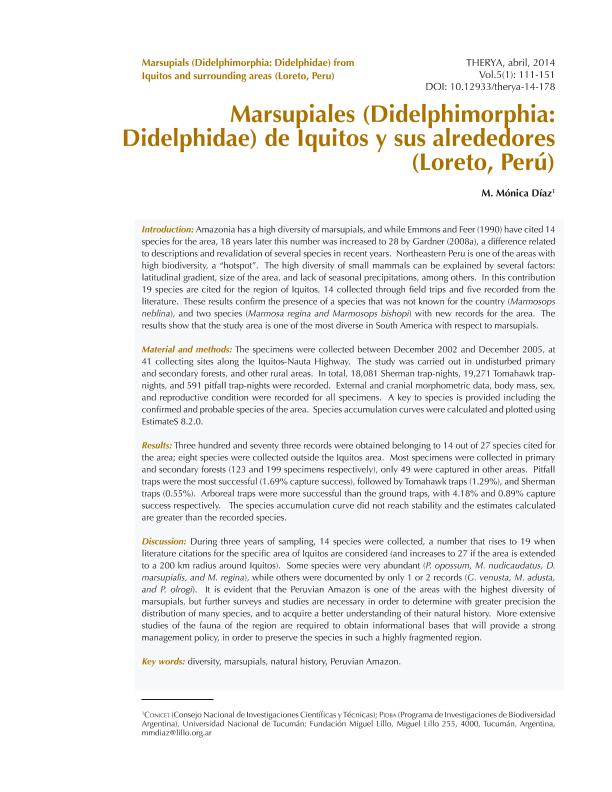Mostrar el registro sencillo del ítem
dc.contributor.author
Díaz, María Mónica

dc.date.available
2016-08-22T14:04:16Z
dc.date.issued
2014-04
dc.identifier.citation
Díaz, María Mónica; Marsupiales (Didelphimorphia: Didelphidae) de Iquitos y sus alrededores (Loreto, Perú); AMMAC; Therya; 5; 1; 4-2014; 111-151
dc.identifier.issn
2007-3364
dc.identifier.uri
http://hdl.handle.net/11336/7256
dc.description.abstract
Se presenta el resultado de un estudio realizado en la localidad de Iquitos y sus alrededores, un área ubicada en la Amazonía del noreste de Perú. Se ofrece una lista de especies de marsupiales registrados mediante colectas realizadas personalmente, información obtenida de la literatura, y registros confiables. Para cada especie se mencionan las localidades de colecta y presentan comentarios sobre su sistemática e historia natural. Se citan 19 especies para Iquitos, 14 fueron colectadas en este estudio, de las cuales una se confirma para el país (Marmosops neblina). Los resultados muestran que esta zona es una de la más diversa en marsupiales en Sudamérica.
dc.description.abstract
Introduction: Amazonia has a high diversity of marsupials, and while Emmons and Feer (1990) have cited 14 species for the area, 18 years later this number was increased to 28 by Gardner (2008a), a difference related to descriptions and revalidation of several species in recent years. Northeastern Peru is one of the areas with high biodiversity, a "hotspot". The high diversity of small mammals can be explained by several factors: latitudinal gradient, size of the area, and lack of seasonal precipitations, among others. In this contribution 19 species are cited for the region of Iquitos, 14 collected through field trips and five recorded from the literature. These results confirm the presence of a species that was not known for the country (Marmosops neblina), and two species (Marmosa regina and Marmosops bishopi) with new records for the area. The results show that the study area is one of the most diverse in South America with respect to marsupials.
Material and methods: The specimens were collected between December 2002 and December 2005, at 41 collecting sites along the Iquitos-Nauta Highway. The study was carried out in undisturbed primary and secondary forests, and other rural areas. In total, 18,081 Sherman trap-nights, 19,271 Tomahawk trap-nights, and 591 pitfall trap-nights were recorded. External and cranial morphometric data, body mass, sex, and reproductive condition were recorded for all specimens. A key to species is provided including the confirmed and probable species of the area. Species accumulation curves were calculated and plotted using Estimates 8.2.0.
Results: Three hundred and seventy three records were obtained belonging to 14 out of 27 species cited for the area; eight species were collected outside the Iquitos area. Most specimens were collected in primary and secondary forests (123 and 199 specimens respectively), only 49 were captured in other areas. Pitfall traps were the most successful (1.69% capture success), followed by Tomahawk traps (1.29%), and Sherman traps (0.55%). Arboreal traps were more successful than the ground traps, with 4.18% and 0.89% capture success respectively. The species accumulation curve did not reach stability and the estimates calculated are greater than the recorded species.
Discussion: During three years of sampling, 14 species were collected, a number that rises to 19 when literature citations for the specific area of Iquitos are considered (and increases to 27 if the area is extended to a 200 km radius around Iquitos). Some species were very abundant (P. opossum, M. nudicaudatus, D. marsupialis, and M. regina), while others were documented by only 1 or 2 records (G. venusta, M. adusta, and P. olrogi). It is evident that the Peruvian Amazon is one of the areas with the highest diversity of marsupials, but further surveys and studies are necessary in order to determine with greater precision the distribution of many species, and to acquire a better understanding of their natural history. More extensive studies of the fauna of the region are required to obtain informational bases that will provide a strong management policy, in order to preserve the species in such a highly fragmented region.
dc.format
application/pdf
dc.language.iso
spa
dc.publisher
AMMAC
dc.rights
info:eu-repo/semantics/openAccess
dc.rights.uri
https://creativecommons.org/licenses/by-nc-sa/2.5/ar/
dc.subject
Didelphimorphia
dc.subject
Diversidad
dc.subject
Perú
dc.subject
Historia Natural
dc.subject.classification
Zoología, Ornitología, Entomología, Etología

dc.subject.classification
Ciencias Biológicas

dc.subject.classification
CIENCIAS NATURALES Y EXACTAS

dc.title
Marsupiales (Didelphimorphia: Didelphidae) de Iquitos y sus alrededores (Loreto, Perú)
dc.title
Marsupials (Didelphimorphia: Didelphidae) from Iquitos and surrounding areas (Loreto, Peru)
dc.type
info:eu-repo/semantics/article
dc.type
info:ar-repo/semantics/artículo
dc.type
info:eu-repo/semantics/publishedVersion
dc.date.updated
2016-08-17T15:40:07Z
dc.journal.volume
5
dc.journal.number
1
dc.journal.pagination
111-151
dc.journal.pais
México

dc.description.fil
Fil: Díaz, María Mónica. Universidad Nacional de Tucumán. Facultad de Ciencias Naturales e Instituto Miguel Lillo. Programa de Investigación de Biodiversidad Argentina; Argentina. Consejo Nacional de Investigaciones Científicas y Técnicas. Centro Científico Tecnológico Tucumán; Argentina
dc.journal.title
Therya
dc.relation.alternativeid
info:eu-repo/semantics/altIdentifier/url/http://132.248.10.25/therya/index.php/THERYA/article/view/17
dc.relation.alternativeid
info:eu-repo/semantics/altIdentifier/url/http://ref.scielo.org/22jwxn
dc.relation.alternativeid
info:eu-repo/semantics/altIdentifier/url/http://www.redalyc.org/articulo.oa?id=402333995006
dc.relation.alternativeid
info:eu-repo/semantics/altIdentifier/doi/http://dx.doi.org/10.12933/therya-14-178
dc.relation.alternativeid
info:eu-repo/semantics/altIdentifier/doi/10.12933/therya-14-178
Archivos asociados
